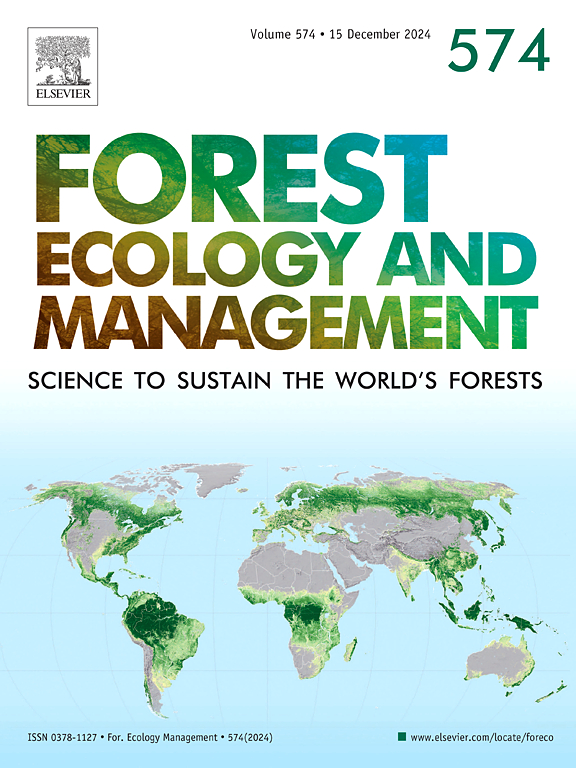Thinning and tending could enhance the understory regeneration potential of seed bank during the subtropical pine forest restoration
IF 3.7
2区 农林科学
Q1 FORESTRY
引用次数: 0
Abstract
Forest restoration is a global priority and the challenge of how to promote the restoration of secondary forests has become a prominent research focus. Compared to active restoration, promoting natural regeneration of dominant species contribute both in sustainability and biodiversity. In the context of coniferous forest conversion, the effect of forest assisted regeneration approaches on natural regeneration potential, especially the role of seed bank, is worth further investigation. We conducted a field study to investigate the difference and influence factor of understory vegetation and seed bank between different Pinus massoniana forest stands formed after thinning and tending measures (shrub cutting and weeding). Furthermore, we explored the effect mechanism of thinning and tending on their density and richness. The results showed that soil (moisture, bulk density and pH), litter (thickness and production) and canopy closure were the crucial factors affecting understory species composition. Thinning increased the understory plant density by increasing litter thickness and moisture, but decreased plant density by reducing soil organic matter and moisture. Similarly, thinning indirectly promoted the seedling density of woody species by reducing canopy closure. Soil (moisture, pH, total potassium and phosphorus) and light variables affected soil seed bank species composition significantly, whereas light and litter variables had significant impacts on litter seed bank species composition. Although thinning had no direct effect on the soil seed bank density, it facilitated the litter seed bank accumulation. Moderate-heavy thinning intensity could enhance seed bank regeneration potential greatly, and understory tending measures further amplified this potential. In summary, thinning and tending measures could enhance the understory regeneration potential of seed bank during the forest restoration.
在亚热带松林恢复过程中,间伐抚育可提高种子库的林下更新潜力
森林恢复是全球优先考虑的问题,如何促进次生林的恢复已成为一个突出的研究热点。与主动恢复相比,促进优势物种的自然更新有利于可持续性和生物多样性。在针叶林转换的背景下,森林辅助更新方式对自然更新潜力的影响,特别是种子库的作用值得进一步研究。通过野外调查,研究了马尾松不同林分在疏养措施(灌木采伐和除草)后林下植被和种子库的差异及其影响因素。进一步探讨了间伐和抚育对其密度和丰富度的影响机制。结果表明,土壤(水分、容重和pH)、凋落物(厚度和产量)和冠层闭合是影响林下物种组成的关键因素。间伐通过增加凋落物厚度和水分增加了林下植物密度,但通过减少土壤有机质和水分降低了林下植物密度。同样,间伐通过减少冠层闭合间接提高了木本物种的幼苗密度。土壤(水分、pH、全钾、全磷)和光照变量对土壤种子库物种组成影响显著,光照和凋落物变量对凋落物种子库物种组成影响显著。间伐对土壤种子库密度无直接影响,但有利于凋落物种子库的积累。中重度间伐强度可显著提高种子库的更新潜力,林下抚育措施进一步放大了这一潜力。综上所述,在森林恢复过程中,间伐抚育措施可提高种子库的林下更新潜力。
本文章由计算机程序翻译,如有差异,请以英文原文为准。
求助全文
约1分钟内获得全文
求助全文
来源期刊

Forest Ecology and Management
农林科学-林学
CiteScore
7.50
自引率
10.80%
发文量
665
审稿时长
39 days
期刊介绍:
Forest Ecology and Management publishes scientific articles linking forest ecology with forest management, focusing on the application of biological, ecological and social knowledge to the management and conservation of plantations and natural forests. The scope of the journal includes all forest ecosystems of the world.
A peer-review process ensures the quality and international interest of the manuscripts accepted for publication. The journal encourages communication between scientists in disparate fields who share a common interest in ecology and forest management, bridging the gap between research workers and forest managers.
We encourage submission of papers that will have the strongest interest and value to the Journal''s international readership. Some key features of papers with strong interest include:
1. Clear connections between the ecology and management of forests;
2. Novel ideas or approaches to important challenges in forest ecology and management;
3. Studies that address a population of interest beyond the scale of single research sites, Three key points in the design of forest experiments, Forest Ecology and Management 255 (2008) 2022-2023);
4. Review Articles on timely, important topics. Authors are welcome to contact one of the editors to discuss the suitability of a potential review manuscript.
The Journal encourages proposals for special issues examining important areas of forest ecology and management. Potential guest editors should contact any of the Editors to begin discussions about topics, potential papers, and other details.
 求助内容:
求助内容: 应助结果提醒方式:
应助结果提醒方式:


